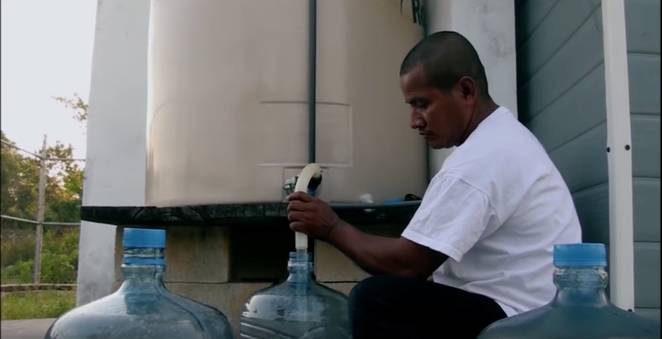Monday, 01/12/2025 | 14:01 GMT+7
This positive change is thanks to an MIT-designed solar-powered water purification system that the village was the first to take for a test drive.
The reverse osmosis system consists of two photovoltaic solar panels that power a set of pumps that push both brackish well water and collected rain water through semiporous membranes that filter and purify the water. The system produces about 1,000 liters of clean water a day for the village's 450 residents.
La Mancalona was chosen as a test site because of its lack of clean water sources and its ample year-round sunshine. The village also had another asset: its residents are mainly subsistence farmers who are very handy and could operate the system on their own.
"When you live in a very rural area, you have to do everything yourself," said MIT researcher Huda Elasaad. "Farming, if there's something wrong with your well, you're the one stuck fixing it, because no one's going to drive into the jungle to help you. So they were very handy, which made it easy for us to train them."
The residents quickly learned how to operate and maintain the technology by themselves. Daily upkeep ranges from changing out ultraviolet lights and filters to testing the water quality and replacing batteries. They get in touch with local suppliers when they need new parts.
The village has turned the system into a business, selling 20-liter bottles of water to residents for an agreed-upon 5 pesos which is far cheaper than the 50-peso bottles of water they had to buy from facility an hour away. The village makes 49,000 pesos or $3,600 a year from the business. A committee sets aside some of that money for the maintenance of the system and then the rest goes back into the community. They also have plans to start selling water to tourists that come to visit the nearby Mayan ruins to add to their profits.

The researchers are excited about the village's new source of income, but they're equally interested to see what effect the system has on the resident's health. Before the system, people couldn't afford clean water, but they could afford soda, which was cheaper. Where children and adults were drinking soda daily, now you see water replacing soda, a shift that will surely have many positive outcomes.
Since the system has proven to be one that can be operated by non-experts with just a little training, the MIT team is ready to distribute it to more areas where clean water is scarce. The researchers say that the system is adaptable to communities in rural villages as well as crowded cities. It can be used with different sources of water and levels of water quality and can be tweaked to work as a reverse osmosis, nanofiltration or elecrtrodialysis system depending on the area's needs.
The technology could bring cheap clean water to hospitals, schools, hotels and more to help boost the health and wealth in these areas.
Mai Linh








 Energy efficiency and sustainable development in textile sector
Energy efficiency and sustainable development in textile sector
 Hoa Phat saves nearly 3,500 billion dong thanks to self-generated electricity
Hoa Phat saves nearly 3,500 billion dong thanks to self-generated electricity
 Enhancing capacity to develop and implement energy efficiency policies at local level
Enhancing capacity to develop and implement energy efficiency policies at local level
 Stanley Vietnam: Targeting a 4% Reduction in Annual Energy Consumption Intensity
Stanley Vietnam: Targeting a 4% Reduction in Annual Energy Consumption Intensity
 Nghe An Industrial Enterprises Proactively Implement Energy-Saving Measures
Nghe An Industrial Enterprises Proactively Implement Energy-Saving Measures
 WEBINAR 1 - Scaling Up Energy Efficiency in Vietnam
WEBINAR 1 - Scaling Up Energy Efficiency in Vietnam
 Bosch Vietnam Plant Benefits from Investment in Energy Efficiency
Bosch Vietnam Plant Benefits from Investment in Energy Efficiency